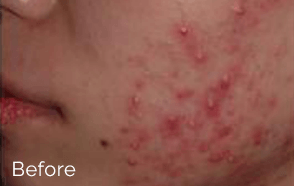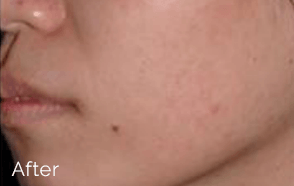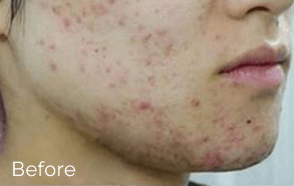Peels are primarily composed of high quality, naturally derived acids. These substances, which include Alpha Hydroxy Acids (AHAs), are sourced from plants and fruits such as apples, grapes, citrus, and sugar cane. Once the solution has been applied to the skin for a set period of time, the acidity is balanced out by adding a neutralizing supplement.
Chemical peels take effect by causing the skin to blister in a well-controlled fashion. Following the procedure, patients experience light erythema (skin reddening), with skin gradually peeling over the subsequent days. Once this peeling process has finished, improvements will be immediately apparent. In the 4-6 weeks that follow the procedure, this positive trend will only continue until the patient is left with a fresh, radiant appearance.
Chemical Peels produce positive and immediate effects for those with fair skin. Patients with dark, olive, or Asian skin can still benefit from a chemical peel, but the depth and strength must be adjusted to avoid the risk of hyperpigmentation. At EverYoung, our dermal physicians will conduct a thorough skin analysis to ensure both safety and results for our patients.
Keeping skin protected from the sun is a critical component in maintaining your results. Apply a full spectrum (UVA and UVB) sunscreen daily to prevent new damage from occurring.
After a chemical peel, restrictions often include avoiding sun exposure, using gentle skincare products, and refraining from picking or peeling the treated skin to ensure proper healing and optimal results.
Before a chemical peel, it’s advisable to avoid using retinoids, undergoing excessive sun exposure, and certain medications to reduce the risk of complications and enhance the effectiveness of the peel.
The waiting time after a chemical peel varies depending on the depth of the peel; for a superficial peel, you may resume regular activities immediately, while medium to deep peels may require a few days to a week of downtime.
The frequency of chemical peels depends on the type and strength of the peel, but a safe interval is typically every 4 to 6 weeks for superficial peels and several months for deeper peels to allow proper skin healing.
Exposure to the sun after a chemical peel can increase the risk of pigmentation changes, sunburn, and complications, so it’s crucial to use sun protection and avoid direct sunlight during the healing period.
No, picking or peeling the skin after a chemical peel is strongly discouraged as it can lead to scarring, infection, and hinder the proper healing process.
The duration of results from a chemical peel varies depending on the type and depth of the peel, with superficial peels lasting a few weeks to months and deeper peels providing longer-lasting effects, potentially several years.
The number of sessions for a chemical peel depends on individual skin concerns and the type of peel used, with some people achieving desired results after a single session, while others may benefit from a series of treatments spaced several weeks apart.
If you don’t moisturize after a chemical peel, the skin may become dry, flaky, and more prone to irritation, potentially prolonging the healing process and affecting the overall outcome.
After a chemical peel, it’s essential to avoid products containing harsh or abrasive ingredients, retinoids, and excessive sun exposure to prevent irritation and support proper skin healing.
Leaving a chemical peel on for too long can lead to excessive skin irritation, redness, peeling, and potentially increase the risk of complications, emphasizing the importance of following the recommended application time.
Washing your face after a chemical peel, especially with a gentle cleanser, is usually recommended to remove any residual peel solution and promote skin healing, but vigorous scrubbing or harsh products should be avoided to prevent irritation.
Chemical peels can be performed on sensitive skin, but it’s crucial to use mild peels, follow proper pre-and post-care routines, and consult with a skincare professional to minimize the risk of adverse reactions.
Chemical peels provide temporary improvements in skin texture, tone, and issues like pigmentation, and their effects are not permanent, requiring periodic treatments for sustained benefits.
After a chemical peel, it’s generally advisable to limit face washing to twice a day using a gentle cleanser to avoid over-cleansing and irritation while the skin is in the healing process.
Chemical peels carry risks such as skin irritation, pigmentation changes, and infection, with severity depending on the peel’s depth and individual skin sensitivity.
The best time to get a chemical peel is typically in the fall or winter when sun exposure is reduced, minimizing the risk of post-peel pigmentation changes and ensuring optimal healing.
Yes, using sunscreen after a chemical peel is crucial to protect the newly treated skin from sun damage and promote proper healing.
It’s advisable to avoid heat, including hot showers and activities that induce sweating, for at least 48 hours after a chemical peel to prevent irritation and promote the skin’s healing process.
The success of chemical peels varies, but they are generally effective in addressing skin concerns such as hyperpigmentation, acne scars, and fine lines, with results dependent on factors like peel depth and individual skin response.
Chemical peels can be effective for treating acne by exfoliating the skin, unclogging pores, and reducing inflammation, but their success may vary depending on the type and severity of acne.
The absence of peeling after a chemical peel could be due to factors such as a superficial peel, individual variations in skin response, or insufficient time for the peeling process to manifest.
The number of skin layers that peel after a chemical peel depends on its depth, with superficial peels typically causing mild flaking, while deeper peels may lead to the shedding of multiple layers over several days.
The number of chemical peels needed to achieve clear skin varies based on individual skin concerns, with a series of treatments usually recommended, spaced several weeks apart, for optimal results.
Before a chemical peel, expect skin preparation and consultation, while after, anticipate temporary redness, possible peeling or flaking, and improved skin texture and tone over time.
Signs that a chemical peel may have gone wrong include excessive redness, blistering, prolonged irritation, or uneven pigmentation, and it’s crucial to consult with a skincare professional for guidance.
It’s generally advisable to wait at least 24 hours after a chemical peel before washing your face to allow the treated skin to recover and minimize the risk of irritation.
Chemical peels are not typically considered relaxing, as they may cause temporary discomfort or a stinging sensation during the application process.
Mild alpha hydroxy acid (AHA) and beta hydroxy acid (BHA) peels, such as glycolic or salicylic acid peels, are considered among the safest face peels when used appropriately and under professional guidance.
The best chemical peel depends on individual skin concerns, but glycolic acid peels are commonly favored for addressing issues like fine lines and hyperpigmentation.
Skin itching after a chemical peel may result from temporary irritation, dryness, or the skin’s healing process, but persistent or severe itching should be discussed with a skincare professional.
While chemical peels can initially cause temporary irritation, they are generally beneficial for treating acne by exfoliating the skin and reducing inflammation when used appropriately and under professional guidance.
Chemical peels can be safe for dark skin when performed by experienced professionals using appropriate formulations and precautions to minimize the risk of post-inflammatory hyperpigmentation.
Yes, chemical peels can enhance skin radiance and promote a glowing complexion by exfoliating the outer layer of dead skin cells and stimulating collagen production.
Chemical peels can help reduce sun damage by exfoliating damaged skin cells, improving texture, and promoting the growth of healthier skin, but multiple treatments may be required for optimal results.
Sweating can potentially irritate the skin and compromise the healing process after a chemical peel, so it’s advisable to avoid activities that induce sweating for a specified period post-treatment.
After a chemical peel, you should typically wait until the skin has fully healed, which can take a few days to a week, before reintroducing skincare products, and it’s important to follow post-peel instructions provided by your skincare professional.
Chemical peels are not suitable for everyone, and eligibility depends on factors such as skin type, specific concerns, and medical history, requiring consultation with a skincare professional to determine suitability.
The healing time after a chemical peel varies depending on its depth, with superficial peels typically healing within a few days, while deeper peels may require a week or more for complete recovery.
The duration of a chemical peel session itself is relatively short, usually taking about 30 minutes to an hour, but the complete process, including recovery, may extend over several days to weeks depending on the depth of the peel.
The duration of the results from a chemical peel varies, with superficial peels providing improvement for a few weeks to months, while deeper peels may offer longer-lasting effects, often requiring maintenance treatments for sustained benefits.
After a chemical peel, it’s crucial to avoid unnecessary touching or picking at the treated skin to prevent irritation and support proper healing.
Picking the skin after a chemical peel can lead to increased irritation, scarring, and potential infection, jeopardizing the desired outcomes of the treatment.
Excessive chemical peels, especially if performed too frequently or with high intensity, can lead to over-exfoliation, increased skin sensitivity, and potential long-term damage, emphasizing the importance of moderation and professional guidance.
Chemical peels can vary in depth, with superficial peels targeting the outermost layer (epidermis), medium peels penetrating the middle layer (dermis), and deep peels reaching the deeper dermal layers, each addressing specific skin concerns based on their depth.
Individuals with active skin infections, a history of keloid scarring, or those currently taking certain medications may be contraindicated for chemical peels, necessitating careful evaluation by a skincare professional.
The number of sessions for chemical peels varies based on individual skin concerns, but a series of treatments spaced several weeks apart is often recommended for optimal results.
Leaving a chemical peel on for too long can result in excessive skin irritation, redness, blistering, and increased risk of complications, emphasizing the importance of following recommended application times.
Chemical peels, particularly those containing salicylic acid, can help reduce blackheads by exfoliating the skin and unclogging pores, but multiple treatments may be needed for significant improvement.
The number of chemical peel sessions for acne varies, but a series of treatments spaced several weeks apart is typically recommended for addressing acne concerns effectively.



























 604-706-1503 (English)
604-706-1503 (English) 604-305-2098 (Chinese)
604-305-2098 (Chinese)
 604-305-2098 (English)
604-305-2098 (English) 604-305-2098 (Chinese)
604-305-2098 (Chinese)
 604-210-6319 (English)
604-210-6319 (English) 604-305-2098 (Chinese)
604-305-2098 (Chinese)
 604-265-7044 (English)
604-265-7044 (English) 604-305-2098 (Chinese)
604-305-2098 (Chinese)



